Having wandered along many of the Cairns Northern Beaches, stepped over fresh water rivers and streams that the rains had created, looking all around us for large reptilians creeping up on us we decide the car is the safest place. We continued our exploration by moving onto the Daintree National Park and Cape Tribulation. On approaching Daintree River where we would make a ferry crossing we saw a sign advertising Bruce Belchers Crocodile Experience. As it had stopped raining, we thought we would observe from a distance, and the safety of Bruce’s boat, the nasty creatures that wanted to eat us.
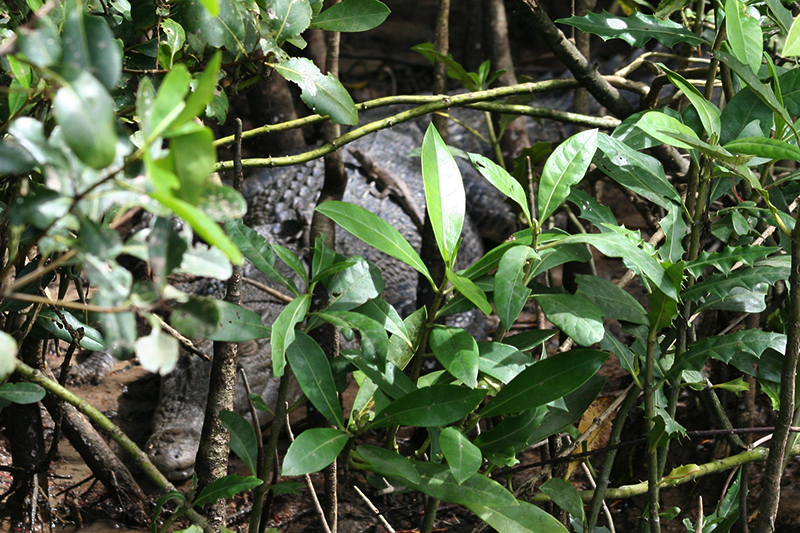 A wizened old chap with a white moustache and a thick Aussie accent arrived and announced himself as Bruce. Squeezing his ample stomach behind the controls, we slid off up the river. After 22 years and 35,000 trips as a tour guide, Bruce was bored and his deadpan delivery virtually sent us to sleep. He only managed to locate crocs by listening to other tour guides on other boats talking to each other on VHF radios, so we saw a couple of youngsters one metre long and about 4 years old and a sixteen year old female who had only 3 of her babies left which she carried on her back. They all seemed like pretty harmless handbags.
A wizened old chap with a white moustache and a thick Aussie accent arrived and announced himself as Bruce. Squeezing his ample stomach behind the controls, we slid off up the river. After 22 years and 35,000 trips as a tour guide, Bruce was bored and his deadpan delivery virtually sent us to sleep. He only managed to locate crocs by listening to other tour guides on other boats talking to each other on VHF radios, so we saw a couple of youngsters one metre long and about 4 years old and a sixteen year old female who had only 3 of her babies left which she carried on her back. They all seemed like pretty harmless handbags.
The great thing about the river is how its surroundings manage to combine the local beauty and wealth of vegetation that spread from the mangrove tree banks of the tidal waters across the plains where cattle and sugar cane compete for space, with the grandeur of the cloudy, distant mountains of the Great Dividing Range. It’s a light green blaize interspersed with the grey-black of tree trunks, cattle and mountain peaks. The richness of the colour is offset by the unpleasant odour of the muddy river as the tide draws the brown water to empty into the clear sea.
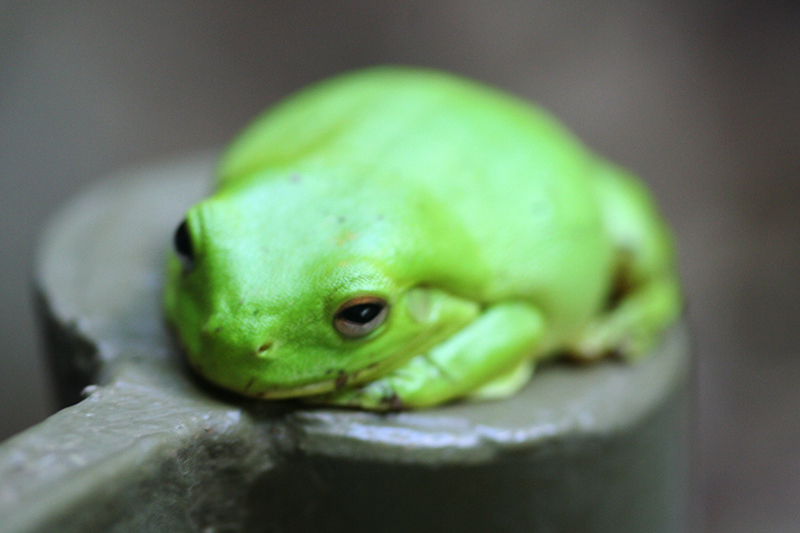 Feeling disappointed that our tin boat had not been attacked by swarms of angry reptiles, we took the ferry across the river and entered the Daintree Rainforest. It’s the oldest tropical rainforest on the planet, 130 million years old and spanning 1,200 square kilometers. Its home to the largest range of plants and animals on earth, including some of the rarest plant species in the world. Then there is the fauna. The wet tropical rainforests in this area contain the richest fauna diversity in Australia. Although it represents less than 1% of the area of Australia, Daintree Rainforest contains 30% of Australia’s frog, marsupial and reptile species, 65% of Australia’s butterfly and bat species and 20% of the bird species. Of course, this depends upon the traveler knowing what they are looking at, so to gain some education, we visited the Discovery Centre.
Feeling disappointed that our tin boat had not been attacked by swarms of angry reptiles, we took the ferry across the river and entered the Daintree Rainforest. It’s the oldest tropical rainforest on the planet, 130 million years old and spanning 1,200 square kilometers. Its home to the largest range of plants and animals on earth, including some of the rarest plant species in the world. Then there is the fauna. The wet tropical rainforests in this area contain the richest fauna diversity in Australia. Although it represents less than 1% of the area of Australia, Daintree Rainforest contains 30% of Australia’s frog, marsupial and reptile species, 65% of Australia’s butterfly and bat species and 20% of the bird species. Of course, this depends upon the traveler knowing what they are looking at, so to gain some education, we visited the Discovery Centre.
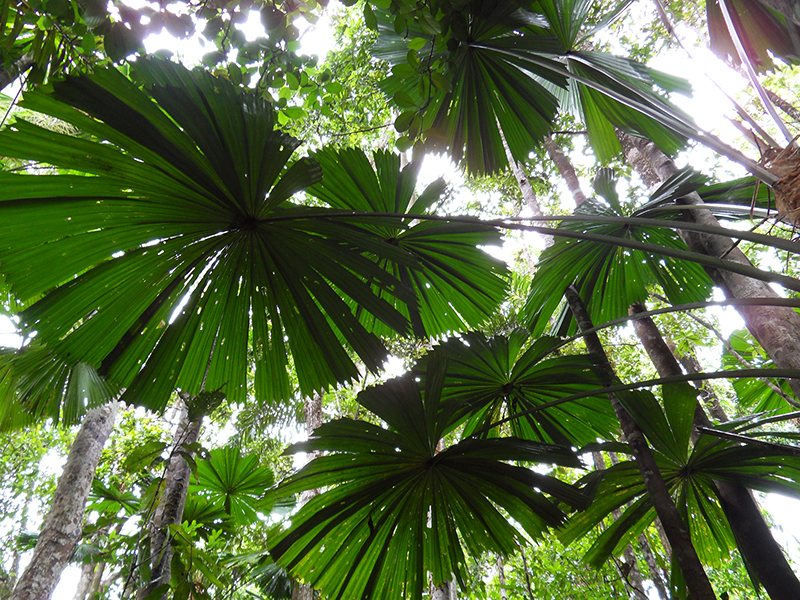 We were struck at once by the contrast in colour of the rainforest compared to the land from where we had come on the opposite bank of the river. Here it was a canvas of deep dark green that begins in the relative space of the forest floor and reaches and thickens up to the busy canopy where the sun was screened out by plants competing for air and light. We spent a surprisingly enjoyable couple of hours looking and learning about a huge diversity of flora that fight for survival in this strange ecosystem but, apart from numerous spiders, we saw precious little fauna. This is typical of jungle environments: you can hear birds, animals and reptiles but you can’t see the blighters.
We were struck at once by the contrast in colour of the rainforest compared to the land from where we had come on the opposite bank of the river. Here it was a canvas of deep dark green that begins in the relative space of the forest floor and reaches and thickens up to the busy canopy where the sun was screened out by plants competing for air and light. We spent a surprisingly enjoyable couple of hours looking and learning about a huge diversity of flora that fight for survival in this strange ecosystem but, apart from numerous spiders, we saw precious little fauna. This is typical of jungle environments: you can hear birds, animals and reptiles but you can’t see the blighters.
As a sop to my desire to spot a snake, they kept a carpet python behind glass in a central education area. The local schoolchildren had taken part in a competition to name said slithery snake and the winning entry named it “Spotted, spot, spot, spot, spotty”. I peered closely at the poor python but I could not detect any spots on it. It raised its head and looked at me as if to say ‘look what they’ve done to me, I can never return to the jungle with such a stupid name. All my mates will laugh at me.’ Yep, I thought, even its victims will die laughing.
There is no electricity this side of the river: everything runs off batteries and generators with the result that, in the evening, everywhere shuts down at 8.00pm, earlier if they can possibly chuck you out. When it was 8.05 and we had eaten our ration of bush tucker, there was only one thing to do: Go down the pub and abuse the locals. We spent two fun filled nights drinking beer and chatting with farmers, fruit pickers and jungle jockeys. We were given drinks and local fruits, heard some of the gossip and were treated incredibly generously by people who were genuinely pleased that we had taken the trouble to spend time with them. They told about the local places to see and to swim safely, places that the tourists don’t find out about and never visit. It was better than any guide book.
Armed with local knowledge, we went to Noah Beach, an unspoilt stretch of golden sand about two miles long that was deserted, except for small well camouflaged sand crabs that rushed around our feet to avoid being crushed by unseeing humans. Coconuts littered the edge of the sands from the palm lined fringe and broken open to reveal their white flesh and small springs of fresh water bubbled from the ground. At sea, the fringing reef broke the battalions of muscular waves so that they lapped softly onto the shore. It would be a classic spot for a Hollywood movie setting when the sun came out but, in the meantime, it was a little known jewel. We ambled along its length and observed all the different sizes of coconuts resting on the sand. If this were in the Pacific Islands, the local girls could find the perfect nuts to wear, there being sufficient variation to accommodate any ample bosom and Debbie discovered a pair that had obviously been sculpted for her by nature. The only problem being that, if I shut my eyes, I could swear that I was fondling a gorilla.
Departing the beach, we found the local swimming hole, where cool, crystal clear water flows from the hills of the rainforest toward the sea. By all accounts, the local crocs do not swim here but we, nonetheless, walked up and down the river banks to check that none were lurking about looking for a soft fleshed foreigner for dinner. Satisfied that we were alone, we stripped off and plunged into the refreshing water that we had to share only with small river trout and kingfishers. It was a wonderful place to spend a few quiet hours, and in the sunshine, before venturing back into the forest again.
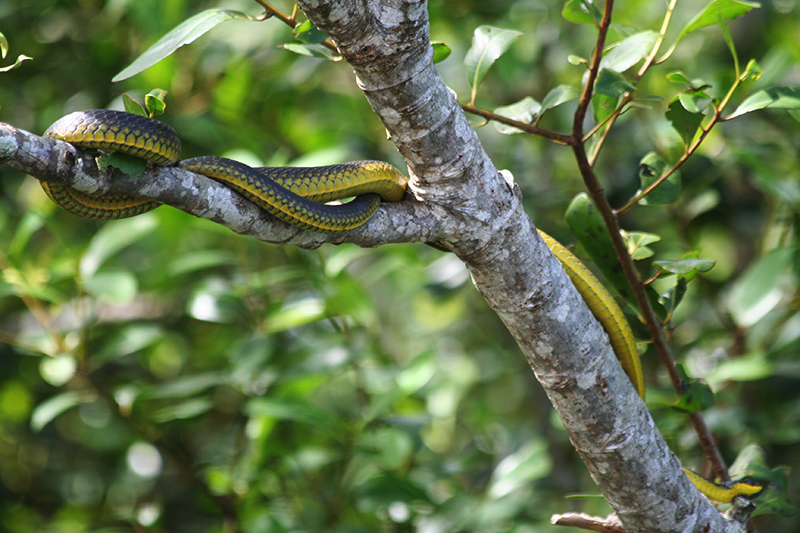 I have to admit that the forest walks, despite being well marked and well trodden, and even sometimes on boards, still made me nervous. I was sure that there were creepy crawlies or slithery snakes just waiting for the unsuspecting. Debbie kindly made me walk in front; having already stepped on two snakes, it was my turn to do the same should the opportunity arise. Spider webs were to be broken and occupants removed to a safe distance. My eyes were put to work, scanning constantly for threats and there was always a sigh of relief when we emerged from the forest unmolested.
I have to admit that the forest walks, despite being well marked and well trodden, and even sometimes on boards, still made me nervous. I was sure that there were creepy crawlies or slithery snakes just waiting for the unsuspecting. Debbie kindly made me walk in front; having already stepped on two snakes, it was my turn to do the same should the opportunity arise. Spider webs were to be broken and occupants removed to a safe distance. My eyes were put to work, scanning constantly for threats and there was always a sigh of relief when we emerged from the forest unmolested.
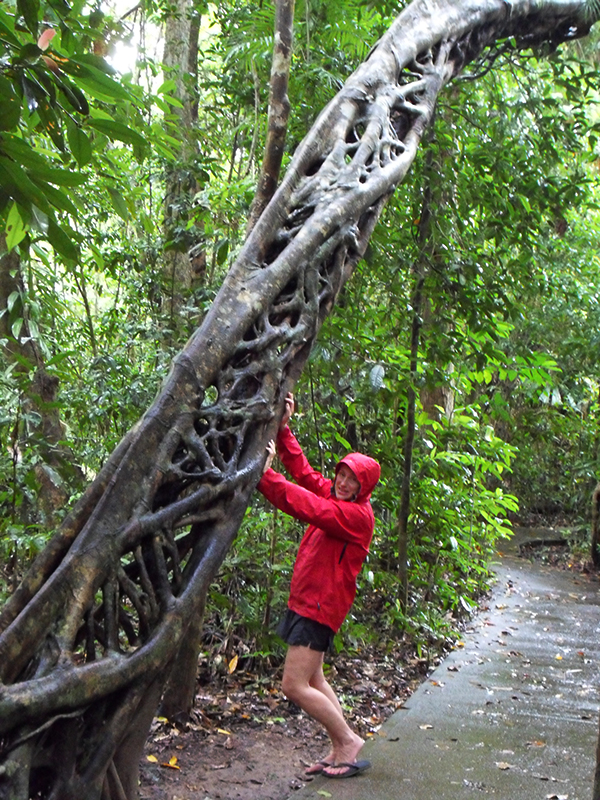 The forest continues for miles and miles – or kilometers being Aussie. Whilst the canopy is dense the floor is muddy, covered with fallen leaves and trees slowly decomposing. Some Bush Turkeys and Scrub Fowls roamed around scratching food from the soil. New shoots search for light where they can spring skywards at great speed to reach the ceiling before another can steal their space. Plants and trees of all shapes and sizes grow side by side to give the forest a diverse almost multicultural aspect. The interdependency was no more obvious than with the large trees. Every tree of any size had a strangler fig wrapped around it, slowly sucking the life away from its host so that, over the years, only the fig would remain.
The forest continues for miles and miles – or kilometers being Aussie. Whilst the canopy is dense the floor is muddy, covered with fallen leaves and trees slowly decomposing. Some Bush Turkeys and Scrub Fowls roamed around scratching food from the soil. New shoots search for light where they can spring skywards at great speed to reach the ceiling before another can steal their space. Plants and trees of all shapes and sizes grow side by side to give the forest a diverse almost multicultural aspect. The interdependency was no more obvious than with the large trees. Every tree of any size had a strangler fig wrapped around it, slowly sucking the life away from its host so that, over the years, only the fig would remain.
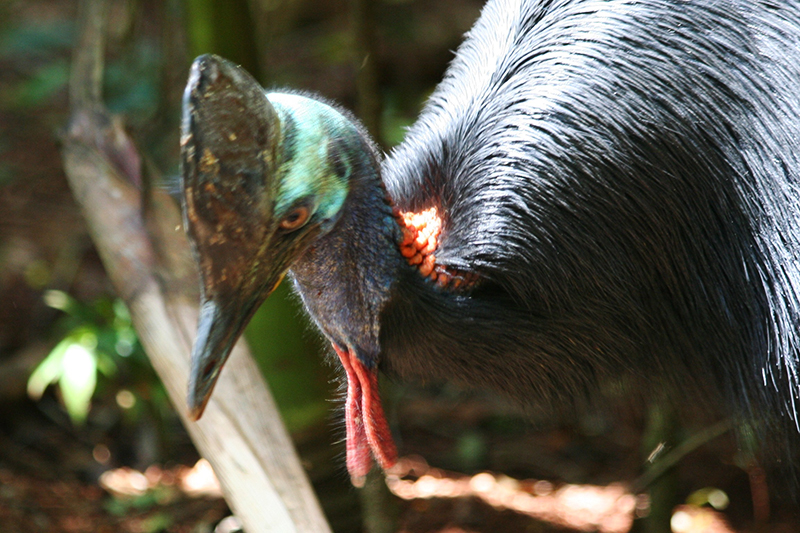 Emerging from the foliage, we came across our first Cassowary, an endangered flightless bird that grows up to 1.8 metres tall. They are pretty docile creatures except when they have youngsters with them when they will attack, using their long sharp talons to spear anything that agitates. They seem to enjoy playing in the road, getting flattened by passing drivers, and there are numerous signs warning drivers to beware their feathered friends. We later drove past one feeding off the roadside debris but Debbie decided not to add it to her already impressive list of roadkill, so we stopped for the obligatory photo before moving on.
Emerging from the foliage, we came across our first Cassowary, an endangered flightless bird that grows up to 1.8 metres tall. They are pretty docile creatures except when they have youngsters with them when they will attack, using their long sharp talons to spear anything that agitates. They seem to enjoy playing in the road, getting flattened by passing drivers, and there are numerous signs warning drivers to beware their feathered friends. We later drove past one feeding off the roadside debris but Debbie decided not to add it to her already impressive list of roadkill, so we stopped for the obligatory photo before moving on.
Sometime later, we arrived at Cape Tribulation, so named because Captain Cook’s ship, The Endeavour, struck a reef off the coast damaging the hull. ‘Here began all our troubles’ he wrote in his diary and, here, very nearly, began our troubles. The rain came down relentlessly; it made the shower in our room seem pathetic. Ten seconds away from shelter and we were soaked to the skin, sufficiently waterlogged that we would have to wring out our bones before going inside.
The rain eventually trapped us in the outside eating area where we remained sheltered under canvass, hoping it would relent sufficiently for us to dash to our room. But it just kept coming: the rainforest has 4 metres of rainfall per annum and it seemed as if the whole lot was arriving at one moment. We stayed put and were forced to remain until we were sufficiently desperate to leave the shelter of the simple awning to go to bed around one in the morning. In the meantime we had discussed such grave subjects as the difference between erotic and kinky (erotic is using a feather; kinky is using the whole chicken) while playing a whole game of Scrabble (which almost caused a fully fledged fight). But the rain persisted and we were forced to ‘borrow’ a large sun umbrella from the beach to retreat to bed.
It rained all night, hammering away angrily on the tin roof without let up and we were convinced that we would be marooned by flooded roads, imprisoned in the jungle until the clouds dissipated. However, to our surprise, we were able to escape the rain-drenched Daintree Forest the next morning and there is nothing like a simple, unexpected stroke of good fortune to lift the spirits.

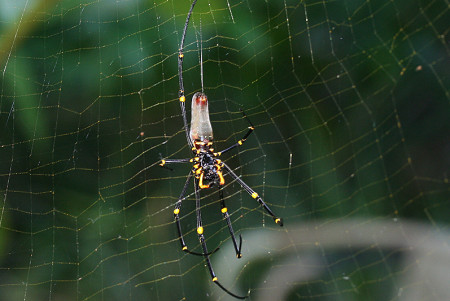
No comments yet.